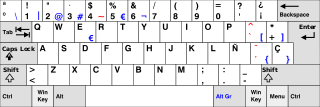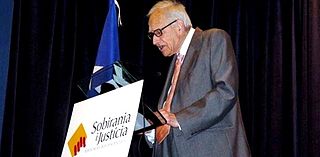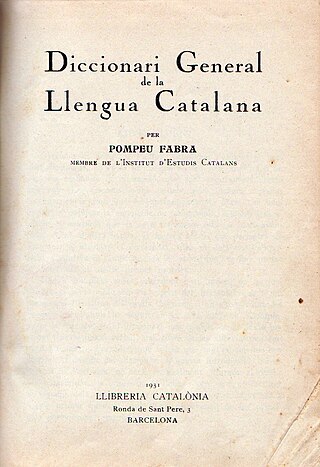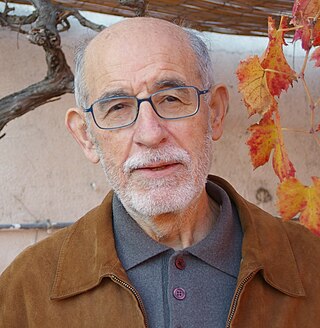
Catalan, known in the Valencian Community and Carche as Valencian, is a Western Romance language. It is the official language of Andorra, and an official language of two autonomous communities in eastern Spain: Catalonia and the Balearic Islands. It is also an official language in Valencia, where it is called Valencian. It has semi-official status in the Italian comune of Alghero, and it is spoken in the Pyrénées-Orientales department of France and in two further areas in eastern Spain: the eastern strip of Aragon and the Carche area in the Region of Murcia. The Catalan-speaking territories are often called the Països Catalans or "Catalan Countries".

Catalonia is an autonomous community of Spain, designated as a nationality by its Statute of Autonomy.

The Institute for Catalan Studies, also known by the acronym IEC, is an academic institution which seeks to undertake research and study into "all elements of Catalan culture". It is based in Barcelona, Catalonia, Spain.

Valencian or Valencian language is the official, historical and traditional name used in the Valencian Community of Spain to refer to the Romance language also known as Catalan, either as a whole or in its Valencia-specific linguistic forms. The Valencian Community's 1982 Statute of Autonomy and the Spanish Constitution officially recognise Valencian as the name of the regional language.
The Catalan and Valencian orthographies encompass the spelling and punctuation of standard Catalan and Valencian. There are also several adapted variants to the peculiarities of local dialects of Insular Catalan.

La Franja is the area of Catalan-speaking territories of eastern Aragon bordering Catalonia, in Spain. It literally means "the strip" and can also more properly be called Franja d'Aragó, Franja de Ponent or Franja Oriental d'Aragó in Catalan.
The Acadèmia Valenciana de la Llengua, also known by the acronym AVL, is an institution created on September 16, 1998, by the Valencian Parliament, which belongs to the set of official institutions that compose the Generalitat Valenciana, according to the Act of Autonomy of the Valencian Community.
Catalan Sign Language is a sign language used by around 18,000 people in different areas of Spain including Barcelona and Catalonia. As of 2012, the Catalan Federation for the Deaf estimates 25,000 LSC signers and roughly 12,000 deaf people around the Catalan lands. It has about 50% intelligibility with Spanish Sign Language (LSE). On the basis of mutual intelligibility, lexicon, and social attitudes, linguists have argued that LSC and LSE are distinct languages.

There are four languages with official status in Catalonia : Catalan; Spanish, which is official throughout Spain; Aranese, a dialect of Occitan spoken in the Aran Valley; and Catalan Sign Language. Many other languages are spoken in Catalonia as a result of recent immigration from all over the world.

Antoni Maria Badia i Margarit was a Catalan linguist and philologist who produced works on the grammar and history of the Catalan language. He was born in Barcelona.

The Catalan language originated from Vulgar Latin in the Pyrenees Mountains between France and Spain. It diverged from the other Romance languages in the 9th century. At that time, Catalan spread quickly throughout the Iberian peninsula when the Catalan counts conquered Muslim territory. By the 11th century, the Catalan language was present in several feudal documents. Catalan was present throughout the Mediterranean by the 15th century. At that time, the city of Valencia was thriving.
Germà Colón i Doménech was a Spanish philologist of Romance philology and Catalan lexicology. He was appointed a professor at the University of Basel, in Switzerland.

The Diccionari General de la Llengua Catalana by Pompeu Fabra is a Catalan dictionary, first published in fascicles in 1931. It was the Standard Catalan dictionary until 1995, when the Institut d'Estudis Catalans published its Diccionari de la llengua catalana.

The Catalan dialects feature a relative uniformity, especially when compared to other Romance languages; both in terms of vocabulary, semantics, syntax, morphology, and phonology. Mutual intelligibility between its dialects is very high, estimates ranging from 90% to 95%. The only exception is the isolated idiosyncratic Alguerese dialect.
The Dictionary of the Catalan language of the Institute of Catalan Studies (DIEC) is the dictionary of Catalan of the Institute of Catalan Studies (IEC) and, therefore, the standard dictionary of and reference for the Catalan language, together with the dictionary of standard Valencian produced by the AVL.

Laia Martínez i López, also known as Laia MaLo, is a Catalan writer and musician.

Eulàlia Lledó i Cunill is a doctor in Romance Philology from the University of Barcelona, a specialist in sexism and language research. She is the author of the first guide in Spain on the treatment of gender violence and media, published in 1999 by the Andalusian Women's Institute and Radio y Televisión de Andalucía. She has received several awards for her work, including the Creu de Sant Jordi in 2008. She is currently a contributor to HuffPost.

Joan Solà Cortassa was a Spanish linguist and philologist. He was professor of Catalan language and literature at the University of Barcelona from 1984 onwards, and vice president of the Institut d'Estudis Catalans (IEC) from 2009.

Bel Olid Báez is a Catalan writer, translator, and teacher of language, literature, translation, and creative writing. They have received several literary prizes, among them the 2010 Documenta Award. From 2015 to 2022, they were the president of the Associació d'Escriptors en Llengua Catalana. As of 2023, they are an Assistant Instructional Professor in Catalan and Spanish at the University of Chicago.
These are lists of spelling-to-sound correspondences in the Catalan language. The two main standard forms are used as primary transcriptions norms of their respective spelling forms.













